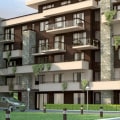Residential properties are essential to urban and rural landscapes, providing housing for individuals and families. While the term "residential property" may seem straightforward, it encompasses a wide variety of housing types, from single-family homes to multi-unit dwellings like apartment complexes. These properties are used solely for living purposes, offering spaces where people can live, relax, and enjoy privacy. In this article, we will explore what constitutes a residential property and provide an example to better understand its function and purpose within real estate.
Defining Residential Properties
A residential property is any building or structure intended primarily for living, as opposed to commercial, industrial, or other non-residential uses. These properties are designed to accommodate individuals, families, or small groups, offering private spaces for daily life. Residential properties differ from commercial properties, which are intended for business or income-generating purposes. While both types of properties are vital to real estate markets, residential properties serve the fundamental need for shelter and housing.
The legal classification of residential property generally includes homes, apartments, condominiums, and townhouses. Whether the property is owner-occupied or rented out to tenants, the main purpose is to provide a place to live. Local governments may also classify these properties differently for taxation or zoning purposes, but the primary use remains the same.
Example of a Residential Property: Single-Family Home
A classic example of a residential property is a single-family home. These standalone houses are designed to accommodate one family or household, typically with separate living, dining, and sleeping areas, as well as outdoor spaces such as a yard or garden. Single-family homes are often located in suburban neighborhoods but can also be found in urban and rural areas.
The most common configuration of a single-family home includes a living room, kitchen, multiple bedrooms, and bathrooms. Many single-family homes also feature additional amenities, such as garages, driveways, basements, and outdoor patios or decks. The design and size of these homes can vary widely, from modest two-bedroom cottages to large estates with expansive square footage and luxury features.
Single-family homes offer privacy, as they are not attached to any other homes or units, unlike apartments or townhouses. This type of residential property is particularly appealing to families looking for space, independence, and a long-term investment. In addition to serving as a place to live, single-family homes are often viewed as one of the most significant financial investments a person or family can make. Homeownership provides stability, tax benefits, and the potential for property value appreciation over time.
Advantages of Single-Family Homes
One of the key advantages of single-family homes is the level of privacy they offer. Because the home is not attached to any other dwelling, homeowners have control over their space, including outdoor areas like backyards and gardens. This privacy extends to noise levels, as homeowners are less likely to be affected by neighboring units.
Another advantage is the flexibility in design and use. Single-family homes can be customized to suit the needs of the occupants, whether through renovations, landscaping, or the addition of amenities like pools or home offices. This flexibility allows homeowners to create a personalized living environment that reflects their lifestyle and preferences.
Furthermore, single-family homes tend to appreciate in value over time, making them a sound investment for homeowners. As the real estate market grows, property values can increase, providing financial benefits if the owner chooses to sell the home in the future. Additionally, single-family homeowners often enjoy access to community resources such as parks, schools, and local services that enhance the quality of life.
Maintenance and Upkeep
While single-family homes provide many benefits, they also come with responsibilities, particularly in terms of maintenance and upkeep. Unlike apartment dwellers or those in shared housing, homeowners are responsible for maintaining both the interior and exterior of their property. This includes tasks such as lawn care, roof repairs, and plumbing maintenance. Depending on the size of the property and the age of the home, these responsibilities can add up, both in terms of time and cost.
However, many homeowners find that hiring professional services can help alleviate some of the burdens of home maintenance. For example, homeowners may hire professionals for landscaping, plumbing, or cleaning services. In fact, much like homeowners seek help with their home maintenance, businesses often rely on commercial cleaning services to maintain cleanliness and order in their workplaces. Just as commercial cleaning ensures a professional and sanitary environment for businesses, homeowners can maintain a clean, organized, and functional space through the use of residential cleaning services.
Conclusion
A residential property, such as a single-family home, provides an essential space for individuals and families to live, offering privacy, independence, and the potential for long-term financial growth. These properties play a fundamental role in meeting the housing needs of people across the globe. The single-family home, in particular, exemplifies the characteristics of residential living, providing the space and flexibility to create a personalized living environment. While maintenance responsibilities may require effort and expense, homeowners have access to professional services to help manage these tasks. Understanding what constitutes a residential property and the benefits they offer can help individuals make informed decisions when purchasing or renting a home.



